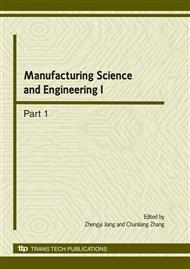p.90
p.96
p.100
p.107
p.111
p.116
p.120
p.126
p.130
Finite Element Simulation of Backward Ball Spinning of Thin-Walled Tube with Longitudinal Inner Ribs
Abstract:
Backward ball spinning is applied to manufacturing thin-walled tubular part with longitudinal inner ribs. Rigid-plastic finite element method (FEM) is used to simulate and analyze backward ball spinning of thin-walled tubular part with longitudinal inner ribs. The fields of stress and strain in the deformation zone of the spun part are obtained by means of FEM. Finite element simulation results show that the deformation zone of the spun part is caused to be in a three-dimensional compressive stress state. The deformation zone in the inner rib is under the tensile strain in the radial and axial direction, and the compressive strain in the tangential direction. The wall deformation zone beside the inner rib is under the compressive strain in the radial direction, and the tensile strain in the axial and tangential direction. The three spinning force components all increase with the increase of the stroke of the ball. Furthermore, of all the three spinning force components, the radial force component is greater than the other two force components, and the tangential force component is minimum.
Info:
Periodical:
Pages:
111-115
Citation:
Online since:
March 2010
Authors:
Price:
Сopyright:
© 2010 Trans Tech Publications Ltd. All Rights Reserved
Share:
Citation:


